Depending on who you are and where you're from your memories of Christmas may include an enormous turkey, a bowl of pasta soup, a pickled fish, a very sore head, a big fat man in a suit, or even a little log pooing presents. Yes, Christmas around the world is a rather odd experience. Here are some of the more fun ways to spend Christmas. Perhaps you can try a few out on the big day!
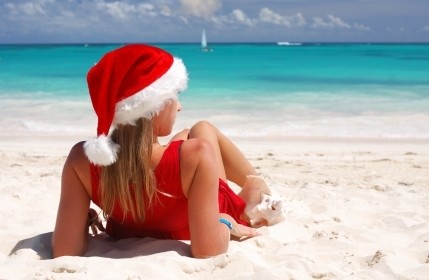 Think United Kingdom but with sun, sand, sea and barbecues. The old man with the beard pops down the chimney on Christmas Eve, drops off the presents for the children, has a glass of sherry, says hello to a few kangaroos and then flies away in his sleigh to continue his duties. Oh and everyone's upside down.
Think United Kingdom but with sun, sand, sea and barbecues. The old man with the beard pops down the chimney on Christmas Eve, drops off the presents for the children, has a glass of sherry, says hello to a few kangaroos and then flies away in his sleigh to continue his duties. Oh and everyone's upside down.
 One of the big days in Colombia is Dec 7. Yes, that's right Dec 7. That's one of the earliest Christmas celebration in the world. It's to honour the immaculate conception, and you thought it took nine months to have a child. Not a baby Jesus. On the night of the 7th the Colombians go crazy for candles lighting them around pavements, parks, houses, shops, dogs, pretty much anything in the way really. Then the 8th is a national holiday for prayers. One week later, on the 16th, the Christmas trees go up and then prayers (the Novena) and singing all the way to early morning on Christmas Day and chicken soup (Ajiaco), bread, fritters (buñuelos), and presents.
One of the big days in Colombia is Dec 7. Yes, that's right Dec 7. That's one of the earliest Christmas celebration in the world. It's to honour the immaculate conception, and you thought it took nine months to have a child. Not a baby Jesus. On the night of the 7th the Colombians go crazy for candles lighting them around pavements, parks, houses, shops, dogs, pretty much anything in the way really. Then the 8th is a national holiday for prayers. One week later, on the 16th, the Christmas trees go up and then prayers (the Novena) and singing all the way to early morning on Christmas Day and chicken soup (Ajiaco), bread, fritters (buñuelos), and presents.
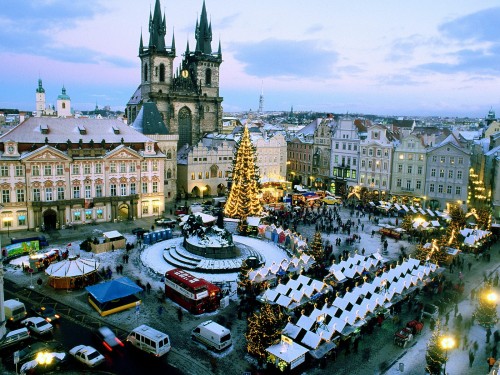 Well if it's Christmas traditions you are after get yourself over to the Czech Republic because they have loads. Christmas Eve is 'open-handed day' for eating and presents, the traditional food being a carp. But the story of the carp is an interesting one. Now gather round children:
Well if it's Christmas traditions you are after get yourself over to the Czech Republic because they have loads. Christmas Eve is 'open-handed day' for eating and presents, the traditional food being a carp. But the story of the carp is an interesting one. Now gather round children:
The story of the carp:
Round the streets of the Czech Republic before Christmas you will see tanks and tanks of carp splashing about in water. People net the ones they want. Then on Christmas Eve they cook their fish in flour, egg, breadcrumbs and oil. But if you put a carp scale under your plate during the dinner you will have enough money for the whole year. And if men keep a carp scale in their wallets they will have enough money for the following 365 days.
The story of the apple: After dinner on Christmas Eve everyone around the table is given an apple. Each person cuts their apple and looks at the core. If the core is a five-pointed star the person will be healthy and lucky. If the core is a four-pointed star the owner will be unhealthy and ill. If the core is a cross the owner must expect the worse. Which all kind of kills Christmas I suppose.
The story of the woman and the shoe: On Christmas Eve single women across the Czech Republic stand throwing shoes over their right shoulders to determine their futures. If the shoe is pointing heel to door then she will remain at home. If the shoe is pointing toe to door then she will be married. If the shoe lands in the sink she will need a new shoe.
The story of the walnut boat: Small boats made from walnut shells and candles are dropped in bowls of water and left to float. If the boat stays close to the side the owner, often a small child, will remain at home for the coming year, which is probably a good thing. If the candle burns a long time then the owner will have a long and happy life.
The story of the molten lead: Now this sounds very medieval but apparently it is not uncommon to see Czechs pouring molten lead into a plate of water. The shape the lead solidifies in will tell the pourer who they are going to marry.
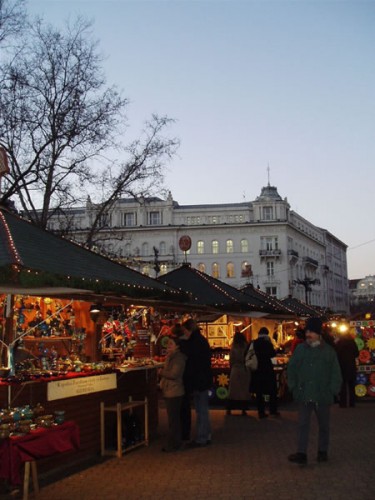 In Hungary there is no such thing as Father Christmas, at least not on Christmas Eve. Saint Nick comes to see children much earlier in the month, on Dec 6 dropping presents and sweets in their polished shoes. On Dec 24th the visitor is more akin to the Devil. A nasty little creature called Krampusz who delivers golden birches to bad children. Still if they're gold what's the problem?!
In Hungary there is no such thing as Father Christmas, at least not on Christmas Eve. Saint Nick comes to see children much earlier in the month, on Dec 6 dropping presents and sweets in their polished shoes. On Dec 24th the visitor is more akin to the Devil. A nasty little creature called Krampusz who delivers golden birches to bad children. Still if they're gold what's the problem?!
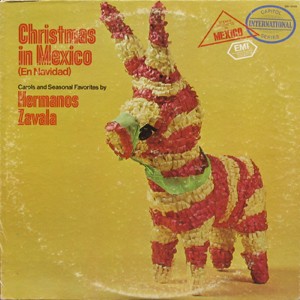 The 'Posadas' take place in Mexico nine days before Christmas Day. Posadas are a reenactment of Mary and Joseph's biblical search for an inn. On each of the nine nights up to Christmas Day two families will tell M and J to go away and one hospitable family will welcome the famous couple into their inn along with statues of Mary and Joseph and a donkey for prayers, songs and lots of religious celebrations. Then comes the 'piñatas', the food, the drink and the tequila.
The 'Posadas' take place in Mexico nine days before Christmas Day. Posadas are a reenactment of Mary and Joseph's biblical search for an inn. On each of the nine nights up to Christmas Day two families will tell M and J to go away and one hospitable family will welcome the famous couple into their inn along with statues of Mary and Joseph and a donkey for prayers, songs and lots of religious celebrations. Then comes the 'piñatas', the food, the drink and the tequila.
As with many Spanish speaking countries the children don't see any presents until January 6th when the Kings visited baby Jesus offering their goodies. In Mexico this day is also celebrated with a Rosca de Reyes, an oval wreath-like cake made of egg with dried fruit and sugar and a little baby Jesus buried inside. The person who bites baby Jesus's toes ends up being his godfather or godmother. But I thought that was God.
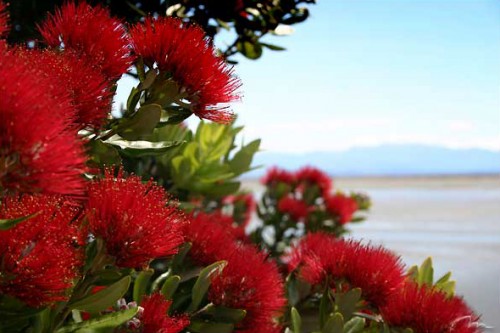 See Australia but replace the word Australia with New Zealand and the word kangaroo with kiwi. There aren't so many barbecues but there is a special New Zealand Christmas tree. It's called the pohutukawa. It's red and quite beautiful.
See Australia but replace the word Australia with New Zealand and the word kangaroo with kiwi. There aren't so many barbecues but there is a special New Zealand Christmas tree. It's called the pohutukawa. It's red and quite beautiful.
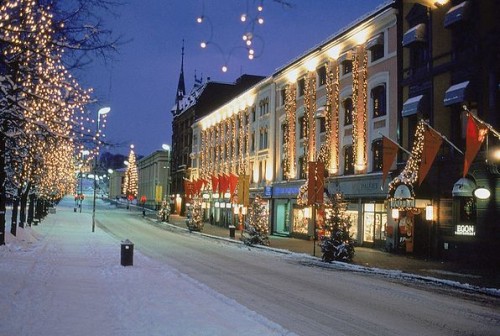 Although many people work in Norway on Christmas Eve it is still considered the most important day. Families eat together and anyone who finds an almond in their rice porridge can receive a little gift. Christmas Day is relaxed and then on Boxing Day people dress up as goats. That's right. It's called 'Julebukk' and the celebration consists of children going door-to-door and receiving gifts, including a Sand Kager which is a special holiday cookie.
Although many people work in Norway on Christmas Eve it is still considered the most important day. Families eat together and anyone who finds an almond in their rice porridge can receive a little gift. Christmas Day is relaxed and then on Boxing Day people dress up as goats. That's right. It's called 'Julebukk' and the celebration consists of children going door-to-door and receiving gifts, including a Sand Kager which is a special holiday cookie.
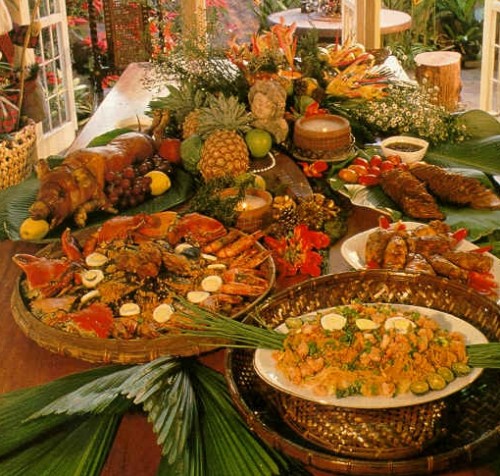 If you really love Christmas then you need to head out to the South Pacific where it's Christmas every day, that is between the days of September and January. But that's pretty good, isn't it? The Philippines has the longest Christmas holiday period in the world during which time locals eat bibingka (a coconut dessert) and puto bumbong (a rice dessert) on banana leaves.
If you really love Christmas then you need to head out to the South Pacific where it's Christmas every day, that is between the days of September and January. But that's pretty good, isn't it? The Philippines has the longest Christmas holiday period in the world during which time locals eat bibingka (a coconut dessert) and puto bumbong (a rice dessert) on banana leaves.
The official holiday season begins on December 16 with a series of nine-day masses: The Simbang Gabi (Cock's Crow) or Misa de Gallo in Spanish (Rooster's Mass) and Misas de Aguinaldo (Gift Masses) from dusk to 3am.
The tree isn't so important in the Philippines. The important thing is the star or the Parol which shines everywhere in huge displays.
Christmas dinner is served at midnight on Christmas Eve (Bisperas ng Pasko or Noche Buena) with a combination of cheeses and ham, rice and seafood as well as hot chocolate or 'tsokolate'. Presents are given early on Christmas morning.
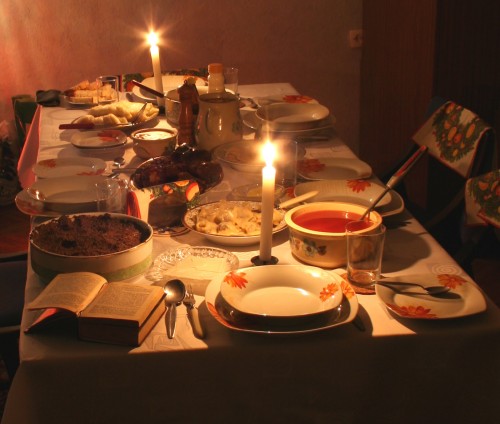 Polish Christmases are full of fun. An extra seat is left at the table for an unknown visitor. The house must be clean. If it's not then it will remain dirty all year. Whatever the weather is doing on Christmas Day in Poland it will do throughout the year. Straw is kept under the dinner table. After dinner women pull out the straw and depending on its colour and length they will either get married, find happiness or die. Whatever happens on Wigilia (Christmas Eve) happens throughout the next year. If the postman comes then there will be happiness and wealth. The Oplatek is very important in Poland. It is a white wafer which is made of flour and water and broken and eaten by Poles all over the world.
Polish Christmases are full of fun. An extra seat is left at the table for an unknown visitor. The house must be clean. If it's not then it will remain dirty all year. Whatever the weather is doing on Christmas Day in Poland it will do throughout the year. Straw is kept under the dinner table. After dinner women pull out the straw and depending on its colour and length they will either get married, find happiness or die. Whatever happens on Wigilia (Christmas Eve) happens throughout the next year. If the postman comes then there will be happiness and wealth. The Oplatek is very important in Poland. It is a white wafer which is made of flour and water and broken and eaten by Poles all over the world.
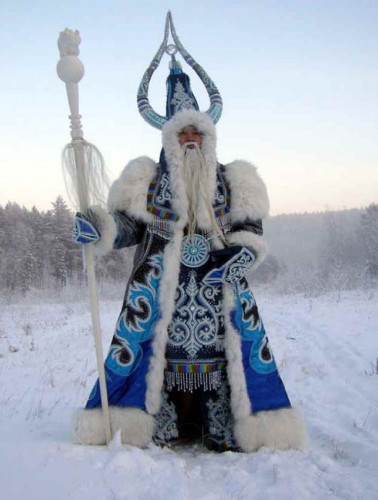 Say the name Father Christmas to children in Russia and the Slavic countries and they won't know what you're going on about. But tell them Grandfather Frost or Grandfather Snow or even better Ded Moroz is on his way with his granddaughter Snegurochka and they will go absolutely beserk. Ded Moroz traditionally delivers the presents door-to-door to children on his horse-driven sleigh. However, in the Ukraine the presents are delivered by little angels.
Say the name Father Christmas to children in Russia and the Slavic countries and they won't know what you're going on about. But tell them Grandfather Frost or Grandfather Snow or even better Ded Moroz is on his way with his granddaughter Snegurochka and they will go absolutely beserk. Ded Moroz traditionally delivers the presents door-to-door to children on his horse-driven sleigh. However, in the Ukraine the presents are delivered by little angels.
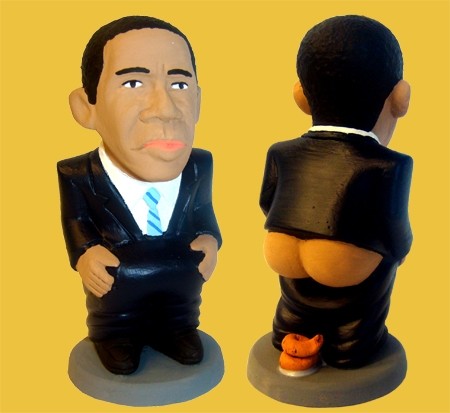 Walk through any plaza (square) in Spain during the holiday season and you're sure to find a long queue of people milling around the traditional model nacamientos (nativity scenes). Oh and you will probably see some giants marching about.
Walk through any plaza (square) in Spain during the holiday season and you're sure to find a long queue of people milling around the traditional model nacamientos (nativity scenes). Oh and you will probably see some giants marching about.
The big day in Spain is January 6th, the day of the Reyes or Kings, with parties, street parades and lots of presents for the children. In recent years Christmas Eve, the 24th of December, has also been celebrated with gifts.
The traditional meal is eaten on the night of the 24th and may include soup, pasta and fish and turron (a soft, sweet nougat) depending on where you are. In Catalunya canelones are eaten and a log with a smiley face called Cagatio is fed sweets and then hit with a stick by children singing 'poo presents!'. And you'll also see lots of market stalls selling caganers which are traditional farmers pooing in the countryside. Recently caganers have become effigies of the most famous people in the world (see picture above!).
On 6th January the traditional Roscon cake, a big circle of dried fruit and sugar, is eaten. It is filled with toys or a bean and the person who finds this is the king for the day.
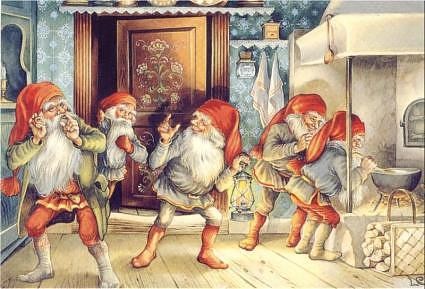 In the past the Swedes fed the Jultomte with porridge on Christmas Eve to ensure they would have presents and luck. It only needed to be a small bowl as the Jultomte was a little gnome. Now the gnome has become the Tomte, similar to Father Christmas, and is usually portrayed by a family member in costume.
In the past the Swedes fed the Jultomte with porridge on Christmas Eve to ensure they would have presents and luck. It only needed to be a small bowl as the Jultomte was a little gnome. Now the gnome has become the Tomte, similar to Father Christmas, and is usually portrayed by a family member in costume.
Also in Sweden December 13th is the day of Saint Lucia. Saint Lucia was a Christian martyr who had her eyes dug out by soldiers but could still see. The night is also the longest of the year. In houses across Sweden the oldest daughter dresses as Saint Lucia (presumably not the island) with a crown of candles and hands out wine and cakes. Clever parents.
 There are of course many many countries across the globe that do not celebrate December 25th as the year of Father Christmas' birthday. One of these is Taiwan who recognise the day as the signing of the Constitution of the Republic of China - December 25, 1947. The hard-working Taiwanese don't even get a holiday for that though.
There are of course many many countries across the globe that do not celebrate December 25th as the year of Father Christmas' birthday. One of these is Taiwan who recognise the day as the signing of the Constitution of the Republic of China - December 25, 1947. The hard-working Taiwanese don't even get a holiday for that though.
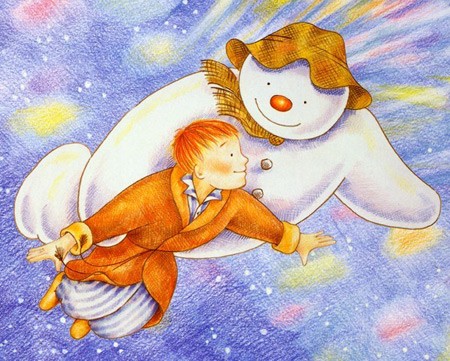 The UK gets its special Christmas tree delivered from Norway every year. It's the centrepiece of Trafalgar Square and goes back to a tradition involving royal families and a few too many glasses of wine. Unlike most northern European countries and many other countries in the world (but that's the UK, always different and slightly awkward) the big day is December 25th.
The UK gets its special Christmas tree delivered from Norway every year. It's the centrepiece of Trafalgar Square and goes back to a tradition involving royal families and a few too many glasses of wine. Unlike most northern European countries and many other countries in the world (but that's the UK, always different and slightly awkward) the big day is December 25th.
For the 25 days leading up to it children open doors on calendars and eat chocolates. Christmas Eve is usually a mix of God and alcohol, and then it's presents, turkey, sprouts, TV and the Queen on Christmas Day itself. Oh and about twenty years ago a choir singer called Aled Jones became the new Jesus Christ thanks to an animation called The Snowman.
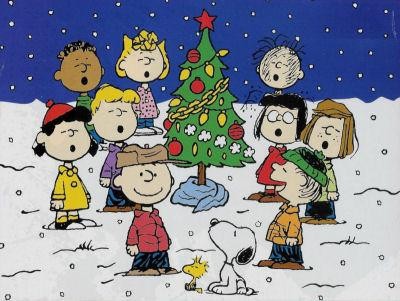 We need to mention America, of course but I think we all know about America since the American way has fast become or is fast becoming THE Christmas way. Even the way you see Santa Claus in your head is thanks to Coca Cola and their red and white design of the old fat fella. Before that Father Christmas was green. Americans eat everything and drink everything at Christmas, they invented shopping and the Christmas film and the Christmas tree and the elf and the angel and ribbon and coal and Charlie Brown. America owns Christmas.
We need to mention America, of course but I think we all know about America since the American way has fast become or is fast becoming THE Christmas way. Even the way you see Santa Claus in your head is thanks to Coca Cola and their red and white design of the old fat fella. Before that Father Christmas was green. Americans eat everything and drink everything at Christmas, they invented shopping and the Christmas film and the Christmas tree and the elf and the angel and ribbon and coal and Charlie Brown. America owns Christmas.
 The start of Christmas in Venezuela could be said to begin in November with the 'Feria de la Chinita', a huge two day Zulian religious party from the 17th to the 19th on behalf of the Virgin Mary of Chiquinquirá. Then it's music, fireworks and fun right through from December 16th.
The start of Christmas in Venezuela could be said to begin in November with the 'Feria de la Chinita', a huge two day Zulian religious party from the 17th to the 19th on behalf of the Virgin Mary of Chiquinquirá. Then it's music, fireworks and fun right through from December 16th.
But the most important thing about Christmas in Venezuela is without doubt the tradition of the big toe.
On Christmas Eve it's customary for locals to rollerskate to mass through the streets of Caracas. In fact many streets are closed. When children go to bed they are said to tie a string to their big toe and let the other end hang out of the window. When the rollerskaters fly past in the morning they tug any strings they see to wake the children up early for presents.
Christmas in... Australia
Christmas in... Colombia
Christmas in... The Czech Republic
The story of the carp:
Round the streets of the Czech Republic before Christmas you will see tanks and tanks of carp splashing about in water. People net the ones they want. Then on Christmas Eve they cook their fish in flour, egg, breadcrumbs and oil. But if you put a carp scale under your plate during the dinner you will have enough money for the whole year. And if men keep a carp scale in their wallets they will have enough money for the following 365 days.
The story of the apple: After dinner on Christmas Eve everyone around the table is given an apple. Each person cuts their apple and looks at the core. If the core is a five-pointed star the person will be healthy and lucky. If the core is a four-pointed star the owner will be unhealthy and ill. If the core is a cross the owner must expect the worse. Which all kind of kills Christmas I suppose.
The story of the woman and the shoe: On Christmas Eve single women across the Czech Republic stand throwing shoes over their right shoulders to determine their futures. If the shoe is pointing heel to door then she will remain at home. If the shoe is pointing toe to door then she will be married. If the shoe lands in the sink she will need a new shoe.
The story of the walnut boat: Small boats made from walnut shells and candles are dropped in bowls of water and left to float. If the boat stays close to the side the owner, often a small child, will remain at home for the coming year, which is probably a good thing. If the candle burns a long time then the owner will have a long and happy life.
The story of the molten lead: Now this sounds very medieval but apparently it is not uncommon to see Czechs pouring molten lead into a plate of water. The shape the lead solidifies in will tell the pourer who they are going to marry.
Christmas in... Hungary
Christmas in... Mexico
As with many Spanish speaking countries the children don't see any presents until January 6th when the Kings visited baby Jesus offering their goodies. In Mexico this day is also celebrated with a Rosca de Reyes, an oval wreath-like cake made of egg with dried fruit and sugar and a little baby Jesus buried inside. The person who bites baby Jesus's toes ends up being his godfather or godmother. But I thought that was God.
Christmas in... New Zealand
Christmas in... Norway
Christmas in... The Philippines
The official holiday season begins on December 16 with a series of nine-day masses: The Simbang Gabi (Cock's Crow) or Misa de Gallo in Spanish (Rooster's Mass) and Misas de Aguinaldo (Gift Masses) from dusk to 3am.
The tree isn't so important in the Philippines. The important thing is the star or the Parol which shines everywhere in huge displays.
Christmas dinner is served at midnight on Christmas Eve (Bisperas ng Pasko or Noche Buena) with a combination of cheeses and ham, rice and seafood as well as hot chocolate or 'tsokolate'. Presents are given early on Christmas morning.
Christmas in... Poland
Christmas in... Russia and Slavic countries
Christmas in... Spain
The big day in Spain is January 6th, the day of the Reyes or Kings, with parties, street parades and lots of presents for the children. In recent years Christmas Eve, the 24th of December, has also been celebrated with gifts.
The traditional meal is eaten on the night of the 24th and may include soup, pasta and fish and turron (a soft, sweet nougat) depending on where you are. In Catalunya canelones are eaten and a log with a smiley face called Cagatio is fed sweets and then hit with a stick by children singing 'poo presents!'. And you'll also see lots of market stalls selling caganers which are traditional farmers pooing in the countryside. Recently caganers have become effigies of the most famous people in the world (see picture above!).
On 6th January the traditional Roscon cake, a big circle of dried fruit and sugar, is eaten. It is filled with toys or a bean and the person who finds this is the king for the day.
Christmas in... Sweden
Also in Sweden December 13th is the day of Saint Lucia. Saint Lucia was a Christian martyr who had her eyes dug out by soldiers but could still see. The night is also the longest of the year. In houses across Sweden the oldest daughter dresses as Saint Lucia (presumably not the island) with a crown of candles and hands out wine and cakes. Clever parents.
Christmas in... Taiwan
Christmas in... The United Kingdom
For the 25 days leading up to it children open doors on calendars and eat chocolates. Christmas Eve is usually a mix of God and alcohol, and then it's presents, turkey, sprouts, TV and the Queen on Christmas Day itself. Oh and about twenty years ago a choir singer called Aled Jones became the new Jesus Christ thanks to an animation called The Snowman.
Christmas in... The United States of America
Christmas in... Venezuela
But the most important thing about Christmas in Venezuela is without doubt the tradition of the big toe.
On Christmas Eve it's customary for locals to rollerskate to mass through the streets of Caracas. In fact many streets are closed. When children go to bed they are said to tie a string to their big toe and let the other end hang out of the window. When the rollerskaters fly past in the morning they tug any strings they see to wake the children up early for presents.